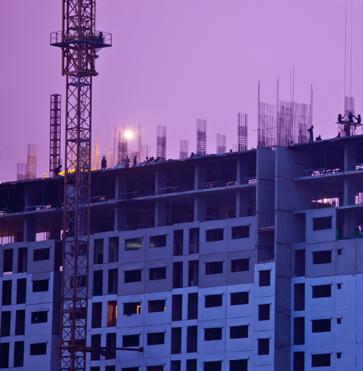
5 minute read
IFC Green Partnerships


Advertisement
Rider Iron and Steel Ghana Limited
IFC provided a loan to Rider Iron and Steel Ghana Limited to help finance the construction of a greenfield steel plant in Ghana that will use mostly locally sourced scrap steel and operate with an energy-efficient induction furnace. By sourcing scrap steel locally, the project is projected to result in a gross avoidance of import-related greenhouse gas emissions of 330,000 tons of CO2 equivalent per year, roughly comparable to the total carbon emissions from 34,000 U.S. homes’ annual energy use.
Kioo Limited
IFC extended a $10 million loan to Kioo Limited, East Africa’s largest glass-packaging manufacturer based in Tanzania, to replace and upgrade its machinery, including the addition of a narrow neck press and blow machine that produces lightweight containers. By reducing the average bottle weight by one-fifth, Kioo has been able to decrease its energy consumption by 10 percent and carbon emissions by over 3,000 tons each year. The company uses 40 percent cullet, or waste glass, in its production, which also saves on energy consumption and emissions.
Indorama Eleme Petrochemicals Limited
Indorama Eleme Petrochemicals Limited, a Nigerian integrated petrochemical company, secured a $64 million loan from IFC to install a new furnace and two new heat recovery generators to reduce its gas consumption. The improvements reduced emissions at the plant by 1.2 million tons of CO2 equivalent.
Sococim Industries
In Senegal, IFC is supporting the country’s largest cement manufacturer, Sococim Industries, as it creates a modernized facility and aims to manufacture cement with one of the lowest emissions levels in the world. As part of IFC’s strategy to help Senegal decarbonize its manufacturing sector, it will provide a 120 million euro loan to Sococim, a subsidiary of French cement maker Vicat S.A. Sococim will use the funds to boost energy efficiency and maximize alternative fuels in its clinkerproduction plant in Dakar, reducing greenhouse gas emissions by more than 300,000 tons of CO2 equivalent per year by 2030.
Conclusion
Decarbonizing heavy industry will require deploying new technologies and substituting fossil fuels with greener energy sources such as biomass, municipal solid waste, and solar and wind energy. IFC's clients such as Dangote Cement in Africa and Indorama Ventures, the world’s largest PET resin producer, are already making the transition by developing cheaper, cleaner, and more efficient ways to power their factories and conserve natural resources. Other companies are investing in carbon capture initiatives and technologies that will allow green hydrogen to be deployed on an industrial scale.
Bringing modern, sustainable technologies to the commercial stage will require a significant financial commitment and robust regulatory support, but it can usher in a new industrial age where businesses flourish, green jobs are created, and carbonless technologies drive development.
IFC, as the largest multilateral finance organization operating in emerging markets today, is well placed to help lead this effort, working with the private sector, governments, and the vast range of players who can together meet this challenge.
References
American Iron and Steel Institute. n.d. “Facts about American Steel Sustainability.” American Iron and Steel Institute website article. https://www.steel.org/wp-content/uploads/2021/11/AISI_ FactSheet_SteelSustainability-11-3-21.pdf.
Backlin, Asa. 2022. “HYBRIT: New Research Shows Hydrogen-Reduced Iron Has Superior Properties.” Hybrit.com news article, October 12, 2022. https://www.hybritdevelopment.se/en/hybrit-newresearch-shows-hydrogen-reduced-iron-has-superior-properties.
Bojek, Piotr. 2022. “Renewable Electricity: More Efforts Needed.” IEA report. https://www.iea.org/ reports/renewable-electricity.
Brudermuller, Martin. 2020. “How to Build a More Climate-Friendly Chemical Industry.” World Economic Forum Annual Meeting, January 21, 2020. https://www.weforum.org/agenda/2020/01/ how-to-build-a-more-climate-friendly-chemical-industry/.
Carbon Sequestration Leadership Forum. n.d. “Al Reyadah Carbon Capture, Use, and Storage (CCUS) Project.” https://www.cslforum.org/cslf/Projects/AlReyadah.
CEFIC. n.d. “Profile: Europe Is the Second Largest Chemical Producer in the World.” The European Chemical Industry Council, Brussels, Belgium. https://cefic.org/a-pillar-of-the-europeaneconomy/facts-and-figures-of-the-european-chemical-industry/profile/.
CemNet. n.d. “The Global Cement Report—Online Database of Cement Plants.” https://www.cemnet. com/global-cement-report/.
Chemical Industries Association. n.d. “Navigating Net Zero.” https://www.cia.org.uk/ Portals/0/Documents/Policy%20Position%20Statements/Navigating%20Net%20Zero. pdf?ver=2022-07-22-093042-183.
Climate Trace. 2022. “Our Story.” https://climatetrace.org/our-story.
de Pee, Arnout, Dickon Pinner, Occo Roelofsen, Ken Somers, Eveline Speelman, and Maaike Witteveen. 2018a. “Decarbonization of Industrial Sectors: The Next Frontier.” McKinsey & Company report. https://www.mckinsey.com/~/media/mckinsey/business%20functions/ sustainability/our%20insights/how%20industry%20can%20move%20toward%20a%20low%20 carbon%20future/decarbonization-of-industrial-sectors-the-next-frontier.pdf.
. 2018b. “How Industry Can Move to a Low-Carbon Future.” McKinsey Sustainability article, July 13, 2018. https://www.mckinsey.com/capabilities/sustainability/our-insights/how-industry-canmove-toward-a-low-carbon-future.
European Commission. 2022. “REPowerEU: Commission Steps Up Green Transition Away From Russian Gas by Accelerating Renewables Permitting.” Press release, November 9, 2022. https:// ec.europa.eu/commission/presscorner/detail/en/IP_22_6657.
. n.d. “European Climate Law.” Climate Action website. https://climate.ec.europa.eu/eu-action/ european-green-deal/european-climate-law_en.
FEVE. 2022. “Furnace for the Future: A Fundamental Milestone Towards Climate-Neutral Glass Packaging.” European Container Glass Federation, March 14, 2022. https://feve.org/glass-industry/projects/furnacefuture/.
GlassOnline. 2020. “Furnace of the Future: A Vision for Climate Neutral Packaging.” GlassOnline.com focus article, April 14, 2020. https://www.glassonline.com/the-furnace-of-the-future-a-visionfor-climate-neutral-packaging/.
Global Cement and Concrete Association. 2021. “Concrete Future: The GCCA 2050 Cement and Concrete Industry Roadmap for Net Zero Concrete." Report. https://gccassociation.org/ concretefuture/wp-content/uploads/2021/10/GCCA-Concrete-Future-Roadmap-DocumentAW.pdf.
Global Energy Monitor. n.d. “Global Steel Plant Tracker.” https://globalenergymonitor.org/projects/ global-steel-plant-tracker/.
Gross, Samantha. 2021. “The Challenge of Decarbonizing Heavy Industry.” Foreign Policy at Brookings, Brookings Institution, Washington, DC. https://www.brookings.edu/wp-content/ uploads/2021/06/FP_20210623_industrial_gross_v2.pdf.
IFC (International Finance Corporation). 2022. “IFC Manufacturing Toolkit for Scaling Up Decarbonization and Circularity Projects.” PowerPoint Presentation, International Finance Corporation, Washington, DC.
. n.d. “IFC Global Manufacturing: Decarbonizing Heavy Industry in Emerging Markets.” PowerPoint Presentation, International Finance Corporation, Washington, DC.
Kamau, Peter Kamicha, Marek Stec, Li Tu, and Sabine Schlorke. 2020. Strengthening Sustainability in the Glass Industry. Washington, DC: International Finance Corporation. https://www.ifc.org/ wps/wcm/connect/5b253a67-c583-46a6-90bb-886a5a9b5838/FINAL_IFC_Glass_7-26-21. pdf?MOD=AJPERES&CVID=nIdwExK.
Ladislaw, Sarah. 2020. “Climate Solutions Series: Decarbonizing Heavy Industry.” CSIS Briefs, October 5, 2020, Center for Strategic & International Studies, Washington, DC.
Leilac. n.d. “The LEILAC2 Project.” Low Emissions Intensity Lime & Cement (LEILAC) Projects website. https://www.proj- ect-leilac.eu/leilac2-project.
Lim, Xiao Zhi. 2021. “How the Chemicals Industry’s Pollution Slipped under the Radar.” The Guardian, November 22, 2021. https://www.theguardian.com/environment/2021/nov/22/chemicalsindustry-pollution-emissions-climate.
Mallagray, Juan Villar, John Anagnostou, Marek Stec, Li Tu, and Sabine Schlorke. 2020. Strengthening Sustainability in the Cement Industry. Washington, DC: International Finance Corporation.
https://www.ifc.org/wps/wcm/connect/242c9ecd-3c4e-4201-839f-0f392a25b41b/IFCStrengthingSustainability-Cement-WEB.pdf?MOD=AJPERES&CVID=nQGkUn7.
McKinsey Sustainability. n.d. “Decarbonizing the World’s Industries: A Net-Zero Guide for 9 Sectors.” McKinsey & Company Our Insights Collection. https://www.mckinsey.com/capabilities/ sustainability/our-insights/decarbonizing-the-world-industries-a-net-zero-guide-for-ninekey-sectors.
Mission Possible Partnership. 2021. “Net-Zero Steel Sector Transition Strategy.” Energy Transitions Commission Net-Zero Steel Initiative report. https://www.energy-transitions.org/publications/ the-net-zero-steel-sector-transition-strategy/#download-form.
Morgan Stanley. 2019. “Decarbonization: The Race to Zero Emissions.” Research report. https://www. morganstanley.com/ideas/investing-in-decarbonization.
Morris, Greg. 2021. “British Glass Publishes Industry-Wide Net Zero Strategy.” Glass International Industry News, July 19, 2021. https://www.glass-international.com/news/british-glass-publishesindustry-wide-net-zero-strategy.
Paragamian, Matthew, John Anagnostou, Li Tu, and Sabine Schlorke. 2021. Strengthening Sustainability in the Steel Industry. Washington, DC: International Finance Corporation. https://openknowledge. worldbank.org/handle/10986/37145#:~:text=Hence%2C%20the%20iron%20and%20steel,of%20 global%20greenhouse%20gas%20emissions.
Pinner, Dickon. 2018. “Decarbonizing Industry Will Take Time and Money—But Here’s How to Get a Head Start.” McKinsey Sustainability Our Insights article, December 14, 2018. https://www. mckinsey.com/capabilities/sustainability/our-insights/sustainability-blog/decarbonizingindustry-will-take-time-and-money-but-heres-how-to-get-a-head-start.
UNEP (United Nations Environment Programme). 2022. “Emissions Gap Report 2022.” UNEP report, October 27, 2022. UN Environment Programme, Nairobi, Kenya. https://www.unep.org/ resources/emissions-gap-report-2022.
UNFCC (United Nations Framework Convention on Climate Change). n.d. “The Paris Agreement: What Is the Paris Agreement?” UNFCCC article. United Nations Framework Convention on Climate Change, Bonn, Germany. https://unfccc.int/process-and-meetings/the-parisagreement/the-paris-agreement.
WEF (World Economic Forum). 2022. “Towards a Net-Zero Chemical Industry: A Global Policy Landscape for Low-Carbon Emitting Technologies.” World Economic Forum white paper, May 2022. World Economic Forum, Davos, Switzerland. https://missionpossiblepartnership.org/wpcontent/uploads/2022/05/WEF_Towards_a_Net_Zero_Chemical_Industry_2022.pdf.
West, Darrell M., and Christian Lansang. 2018. “Global Manufacturing Scorecards: How the U.S. Compares to 18 Other Nations.” Brookings Institution report executive summary. Brookings Institution, Washington, DC. https://www.brookings.edu/research/global-manufacturingscorecard-how-the-us-compares-to-18-other-nations/.
White House, U.S. 2022. “Executive Order on the Implementation of the Energy and Infrastructure Provisions of the Inflation Reduction Act of 2022.” Executive order, September 12, 2022. The White House, Washington, DC. https://www.whitehouse.gov/briefing-room/presidentialactions/2022/09/12/executive-order-on-the-implementation-of-the-energy-andinfrastructure-provisions-of-the-inflation-reduction-act-of-2022/.



